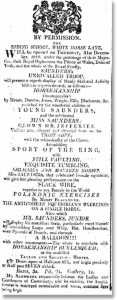Equestrian, Circus Proprietor
 Undoubtedly the most famous of the Saunders family, Abraham played a significant role in the development of the early modern circus in England. He was born in 1748 to a Jewish father who managed a travelling fairground act. In his teenage years he performed with his brother, equilibrist Samuel Saunders. In the mid-1770s the brothers were taken into Philip Astley’s company when the great circus manager expanded his entertainments to include slack wire and acrobatic acts. They became part of ‘Astley’s Jews’, the derogatory title given to talented Jewish itinerant performers who were the essential core of Astley’s growing business.
Undoubtedly the most famous of the Saunders family, Abraham played a significant role in the development of the early modern circus in England. He was born in 1748 to a Jewish father who managed a travelling fairground act. In his teenage years he performed with his brother, equilibrist Samuel Saunders. In the mid-1770s the brothers were taken into Philip Astley’s company when the great circus manager expanded his entertainments to include slack wire and acrobatic acts. They became part of ‘Astley’s Jews’, the derogatory title given to talented Jewish itinerant performers who were the essential core of Astley’s growing business.
When his father died Abraham took over the fairground act and converted it to become one of England’s first travelling circuses. Rather than the usual equestrian outfit, he wore a squire’s suit of a bright scarlet coat, white shirt and cravat, buckskin breeches, high boots, with a white top hat. This startling look was later adopted by American circuses the following century, and is still used by many ringmasters in today’s circuses.
Around 1769 Abraham married Elizabeth, a partnership that would last almost 70 years. It is not certain how many children they had but at least three are known: Rebecca, Abraham junior and Sarah.
For many years Abraham travelled throughout England and Ireland exhibiting mainly on the fair circuit. The annual London fairs were also essential stops on his calendar. His ever-changing cast included many who would later mark their names in circus history such as Peter and Andrew Ducrow, Edmund Kean, the Great Belzoni and Henry Hengler.
During the early 1800s circus became a popular form of entertainment and Abraham’s troupe often performed for royalty. In such a competitive environment, Abraham’s shows became more elaborate with fireworks, mechanical scenery, tight rope dancing, slack rope vaulting, slack wire equilibriums, as well as the usual equestrian trick acts. He outlaid great expense to hire noted acts and often reviews were extremely positive as were the profits. But the good times were infrequent as some of his ventures failed and several times he was declared bankrupt.
Good fortune was in the winds of 1821 as Abraham was entrusted with transporting the King’s much loved and valued Royal Hanovarian Creams, considered the most elite of horses, to Ireland for the King’s visit. Abraham also transported his own stud for circus shows during the tour. It is thought that whilst the royal horses were shipped without event, Abraham’s entire troupe was lost in a severe storm in the Irish Channel.
When aged in his 70s Abraham’s exhibitions were more limited in number and flamboyance. He confined his shows to fairs in and around London despite the authorities attempting to rid the city of a plethora of unlicensed entertainment venues. More than once Abraham was up before the authorities for conducting unlicensed penny gaff theatres.
Abraham’s final public exhibitions were in 1838 at London fairs. He then retired but was reduced to poverty in his final months. Some of his former cast came to his aid to make sure he was comfortable in his last days.
Abraham died on 26 July 1839, aged 91. All major newspapers noted his passing, calling him The Celebrated Showman.
For almost three-quarters of a century this great man was a trail blazer in entertainment. His company travelled for decades entertaining thousands, and perhaps millions of people. So many performers were trained by him, then moved on to make their own fame and fortune. Yet his life was also tinged by tragedy and misfortune. Some circus historians criticise him as a poor business manager, hence his failures. But he was also a grand master and champion of the modern circus whose impact can still be seen to this day. When next you see a circus ringmaster standing tall in the flamboyant red suit and top hat, remember Abraham Saunders.
(Advertisement from The Kentish Gazette 18 December 1810. Image © The British Library Board. All rights reserved. Image reproduced with kind permission of The British Newspaper Archive www.britishnewspaperarchive.co.uk)
Contact Caroline Cavanagh at samwellcircus@tpg.com.au to purchase a copy of Once a Famous Circus which provides much more detail on the Saunders and Samwell travelling circus families.
Text © Caroline Cavanagh 2017.